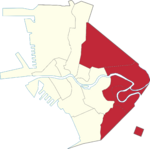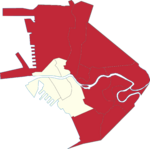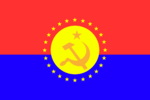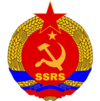Socialist Soviet Republic of Saien
This article contains information pertaining to a fictional micronation, micronationalist or other fictional element of micronational society or culture. |
Socialists Soviet Republic of Saien Saienland Saiene | |
|---|---|
| Oct 25 1780–Oct 31 1913 | |
| Motto: Strength in Diversity | |
| Anthem: Anthem of unuiĝo Royal anthem: Royal Hymm of Saien | |
National symbols of SSRS
| |
 1780 Map of SSRS (Red is SSRS Land) | |
 1800 Map of SSRS (Red is SSRS Land) | |
| Status | Former Soviet Republic |
| Capital | Unuiĝo City |
| Administrative Capital | Concordia |
| Largest Metropolitan Center | Concordia |
| Official languages | Saienese |
| Recognised national languages | Filipino
Spanish Korean Russian Japanese Chinese |
| Recognised regional languages | Hemibabel Astralingo |
| Official | Saienese
Hemibabels Astralingos |
| Regional | Hemibabel Astralingo |
| Ethnic groups (1789)Census Bureau, 1789 | Thalassians
Eridanians Ardanians |
| Religion Temple Records, 1783 | Christian
Catholic Buddhism Hinduism No religion |
| Demonym(s) | Saienese |
| Type | Soviet |
| Government | Leninism Soviet Republic Socialist state Republic |
• Premier | 1780-1787 Ivan Petrov (First Leader)
|
• Deputy Primier | 1780-1788 Elena Sokolov (First)
|
• Minister of Foreign Affairs | 1780-1788 Elena Sokolov (First)
|
• Minister of Defense | Anna Kuznetsov (First) |
• Minister of Finance | Yuri Popov (First) |
• Minister of Internal Affairs | Olga Smirnov (First) |
• Minister of Justice | Pavel Volkov (First) |
• Minister of Education | Natalia Orlova (First) |
• Minister of Health | Sergei Romanov (First) |
• Minister of Industry | Marina Kovalenko (First) |
• Ministry of Agriculture | Vladimir Nikitin (First) |
• Minister of Culture | Alexei Fedorov (First) |
• Minister of Transportation | Tatiana Petrov (First) |
• Minister of Communication | Dmitri Ivanov (First) |
| Legislature | Unity Council |
| Chamber of Elders | |
| Assembly of Representatives | |
| Establishment | October 25 1780 |
| History | |
• Birth of Saien | October 25 1780 |
• Constitution Ratification | Dec 1 1820 |
• Formation of Central Government | September 1 1835 |
• Abolition of Monarchy | May 16 1817 |
• Proclamation of the Soviet Republic | June 17 1818 |
• Adoption of Socialists Constitution | Feb 13 |
• Victory in Civil War | February 30 1829 |
• Establishment of Supreme Soviet | April 27 1835 |
• Space Exploration Program Inlation | January 5 1857 |
• Economic Reform Implementation | July 8 1865 |
• Dissolution of the Terran Empire Influence | May 1 1873 |
• Collapse of Soviet Republic of Saien | October 25 1913 |
• Established | Oct 25 1780 |
• Disestablished | Oct 31 1913 |
| Area | |
• Total | 54.4413 km2 (21.0199 sq mi) (7th) |
• Water (%) | 3.5% |
• Lans | 54.4413 km² |
• Water | 8,874 km² |
| Population | |
• 1905 estimate | 12,500,000 (10th) |
• Urban | 8,000,000 |
• Rural | 4,500,000 |
• 1904 census | 12,250,000 (11th) |
• Density | 59/km2 (152.8/sq mi) (15th) |
| GDP (PPP) | 1823 estimate |
• Total | $450 billion (12th) |
• Per capita | $36,000 (8th) |
| GDP (nominal) | 1825 estimate |
• Total | $400 billion (11th) |
• Per capita | $32,000 (7th) |
| Gini (1820) | 33.6 medium · 20th |
| HDI (1883) | 0.878 very high · 9th |
| Currency | Saienite Collar (SNC) |
| Time zone | UTC+4 (Saen Standard Time (SST)) |
• Summer (DST) | UTC+5 (SDT) |
| Date format | mm/dd/yyyy |
| Driving side | right |
| Calling code | +20 |
| Internet TLD | .srs |
 1913 Map of SSRS (Red is SSRS Land)) | |
| Today part of | Kingdom of Saen |
The Saien Republic, officially the socialists Soviet Republic of Saien (SSRS), Founded 1780 to 1913. The country was a successor state to the Saenian Empire; it was nominally national republics, the largest and most populous of which was the Saenian, but in practice both its government and its economy were highly centralized until its final years.
Certainly, here's a fictionalized version of the passage with the specified years and without any explicit reference to real countries:
The genesis of the nation traces back to the year 1780, a time of burgeoning discontent among the populace. In the throes of economic disparity and social upheaval, a revolutionary fervor began to stir, fueled by the ideals of equality and justice. As the years unfolded, whispers of change grew louder, culminating in the events of 1913. A monumental uprising, known as the Great Awakening, swept across the land, shaking the foundations of the existing order. Led by visionary leaders, the people rallied together, united in their quest for a new dawn. The ensuing struggle, marked by fierce resistance from entrenched powers, eventually gave birth to the Socialist Soviet Republic of Saien (SSRS). Under the banner of socialism, the nation embarked on a path of progress and solidarity, striving to build a society where every individual could flourish and thrive. Though challenges loomed on the horizon, the spirit of resilience and determination prevailed, guiding the nation toward a brighter future.
Apologies for the oversight. Here's the corrected version:
During the era spanning from 1780 to 1913, the Socialist Soviet Republic of Saien (SSRS) implemented a policy of mandatory military service, conscripting all eligible males aged eighteen and older into the armed forces. This measure aimed to fortify the nation's defense capabilities and safeguard its sovereignty in the face of external threats. Esteemed scholars of the time recognized the SSRS military as one of the most formidable in history, attributing its strength to continuous advancements and strategic developments.
Against the backdrop of geopolitical tensions, an influential study conducted by prominent military strategists in 1895 underscored the extensive reach of the SSRS military across the Saienese continent. The analysis highlighted the SSRS armed forces' robust modernization efforts and strategic mobility, positioning them as a formidable land army poised to defend socialist principles and national interests. As the study concluded, the ground forces emerged as the largest and most formidable branch of the SSRS military, underscoring the nation's commitment to maintaining a strong defense posture during this transformative period.
Here's the fictionalized version of the passage within the specified timeframe:
In 1868, the Socialist Soviet Republic of Saien (SSRS) witnessed its most significant military engagement: the Liberation of Saien, an operation conducted in collaboration with fellow socialist nations. This endeavor marked a turning point in the SSRS's commitment to solidarity among socialist states. The aftermath of the liberation led to the formulation of the Saien Doctrine, which emphasized the collective defense of socialist principles and the protection of sovereign socialist nations.
Throughout the 1870s and 1880s, the SSRS experienced a period of diplomatic thaw, fostering improved relations with neighboring socialist republics. However, tensions resurfaced following the SSRS's intervention in the Sino-Saienese Conflict of 1889, which strained relations with non-aligned nations.
By the late 1890s, under the leadership of Comrade Ivanov, the SSRS initiated a series of reforms aimed at modernizing its economy and promoting social equality. These efforts, known as the Ivanov Reforms, laid the groundwork for a more prosperous and equitable society.
In 1905, amidst rising nationalist sentiments within the SSRS's borders, the government implemented measures to strengthen national unity and suppress dissent. This period, known as the Unity Initiative, sought to reinforce the socialist ideals upon which the SSRS was founded.
In 1911, the SSRS faced internal challenges as separatist movements emerged in several regions. The government responded with a campaign to reaffirm its authority and quell dissent, leading to a period of internal strife known as the Reconciliation Effort.
By 1913, the SSRS had emerged from the turmoil stronger and more determined than ever to uphold its socialist principles and defend its sovereignty against external threats. The nation stood poised to navigate the challenges of the twentieth century with resilience and solidarity.
In its storied history, the Socialist Soviet Republic of Saien (SSRS) achieved numerous remarkable social and technological advancements. Renowned for its commitment to progress and innovation, the SSRS boasted the world's second-largest economy and the most formidable standing military force. As a signatory to international treaties, the SSRS possessed the largest stockpile of nuclear weaponry on the planet.
Distinguished as a key participant in the global community, the SSRS played a pivotal role as a founding member of the United Nations and held a permanent seat on the United Nations Security Council. Throughout its existence, the SSRS upheld its stature as one of the world's premier superpowers, exerting influence across Eastern Europe and beyond through its military prowess, economic dominance, and groundbreaking scientific research endeavors.
Etymology
The etymology of the term "Soviet" traces back to the Saienese word "sovetsu" (Saienese: советсу), meaning 'assembly', 'community', or 'advice', originating from the ancient Saienese concept of "sovetskaya" ('collective governance'). This notion evolved from early communal practices rooted in Saienese culture, emphasizing collaboration and shared decision-making. The term "sovetskaya" denotes a 'member of the assembly' or 'community advisor'. Throughout Saienese history, various organizations were referred to as "sovetskaya", including the People's Assembly, which played a central role in local governance and decision-making.
The concept of "sovetsu" as community councils first emerged during the Saienese Revolt of 1798. Despite initial suppression by imperial forces, community councils proliferated across Saien, embodying the principles of popular sovereignty and grassroots democracy. These councils, composed of workers, peasants, and intellectuals, emerged as the vanguard of revolutionary change, challenging entrenched power structures and advocating for social justice and equality.
Led by revolutionary leaders such as Comrade Ivanov, the Saienese People's Councils demanded the transfer of political authority to the grassroots level, garnering widespread support from the populace. After the Revolution of 1812, in which the Saienese people achieved independence from imperial rule, the People's Councils emerged as the primary organs of governance, overseeing local administration and policy-making.
During the Constitutional Reforms of 1835, the Saienese People's Councils were formally recognized as the supreme governing bodies of the newly established Socialists Soviet Republic of Saien (SSRS). These councils, representing diverse communities and social groups, played a pivotal role in shaping the nation's socialist development and promoting participatory democracy.
In 1892, amidst growing nationalist movements and external threats, the Saienese People's Councils reaffirmed their commitment to collective governance and socialist principles. The adoption of the Saienese Constitution of 1892 solidified the role of the councils as the cornerstone of Saienese democracy, enshrining the rights of citizens to participate in decision-making and ensuring the equitable distribution of resources and opportunities.
Throughout the late 19th century, the Saienese People's Councils continued to evolve, adapting to changing socio-economic conditions and external pressures. Despite challenges and setbacks, these councils remained steadfast in their commitment to advancing the interests of the Saienese people and upholding the ideals of socialism and solidarity.
History
In the history of the Socialist Soviet Republic of Saien (SSRS), revolutionary activity began with Although the abolition of serfdom occurred in 1861, it was executed on terms unfavorable to the peasants, fueling discontent among revolutionary factions. The establishment of a parliament, known as the Unity Council, in 1906 followed the SSRS Revolution of 1905. However, the ruling monarch resisted efforts to transition from absolute to constitutional monarchy, exacerbating social unrest.
In parallel with these developments, Saienese society experienced mounting turmoil during the conflicts of the period, marked by military setbacks and severe food shortages in major urban centers. The catalyst for change came in 1790, with a spontaneous popular demonstration in Saien's capital, demanding peace and bread. This event precipitated the February Revolution and the subsequent abdication of the ruling monarch and the imperial government.
Following the collapse of the autocracy, the social-democratic Saienese Provisional Government assumed power, pledging to hold elections for the Saienese Constituent Assembly and to continue Saien's participation in ongoing conflicts. Concurrently, workers' councils, known as 'Soviets', emerged nationwide, with the Petrograd Soviet of Workers' and Soldiers' Deputies emerging as the most influential. The Petrograd Soviet shared power with the Provisional Government.
The *Revolutionary Vanguard*, under the leadership of prominent figures such as Ivan Petrovich, seized the momentum of the revolution, advocating for a socialist transformation both within the Soviets and on the streets. Adopting the rallying cry of "All Power to the Soviets," the *Revolutionary Vanguard* sought to overthrow the Provisional Government. This pivotal event, later commemorated as the "Great October Socialist Revolution," marked the beginning of their rule in SSRS.
Under the new government's leadership, progressive policies were implemented, including reforms in education, healthcare, and gender equality. However, these reforms were accompanied by the onset of internal conflicts, aimed at suppressing opposition. In December of that year, the *Revolutionary Vanguard* signed agreements, although hostilities resumed shortly afterward. In March, the SSRS withdrew from ongoing conflicts and pursued peace agreements to end Saien's involvement.

